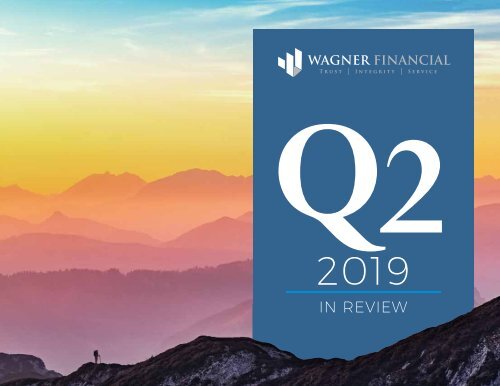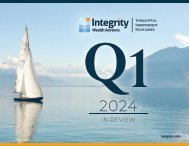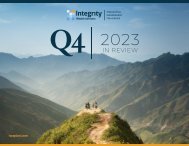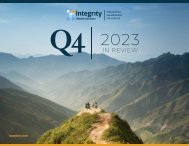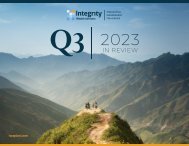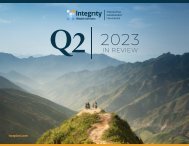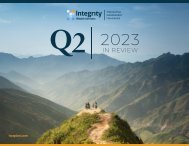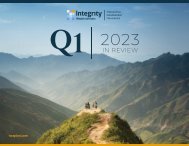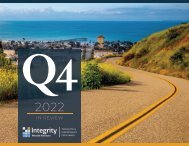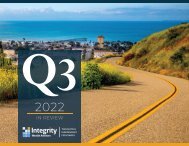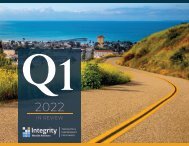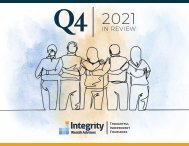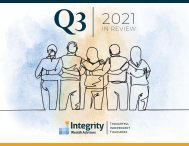2019 Q2 In Review - Wagner Financial, Ventura, CA
You also want an ePaper? Increase the reach of your titles
YUMPU automatically turns print PDFs into web optimized ePapers that Google loves.
<strong>Q2</strong><br />
<strong>2019</strong><br />
IN REVIEW
COMMENTARY<br />
The U.S. economy is entering its 11th consecutive year of growth that began in July<br />
2009, setting a new record for the length of an economic recovery and expansion.<br />
Since World War II, the average expansion has lasted about five years, and the<br />
previous record was the 10-year period that began in March 1991. Growth has<br />
been accelerating over the past year-and-a-half, but as the economy heads into<br />
record territory this month, there still lies uncertainty around global trade. This<br />
has continued to dampen the benefits of fiscal support provided by the Tax Cuts<br />
and Jobs Act of 2017 and may be discouraging productivity-enhancing capital<br />
investment. We still believe self-interest is likely to bring the United States and<br />
China back to the negotiating table, but until we see progress, trade tensions remain<br />
the primary risk to the economy. We think the next several months are more likely to<br />
lead to trade deals than an expansion of tariffs, as the election in 2020 approaches.<br />
Consumer attitudes have been on an erratic journey of ups and downs since the<br />
expansion began. Most often consumers tend to be confident about the future when<br />
they are confident about the present. Consumer confidence generally moves in line<br />
with economic variables such as interest rates, inflation and unemployment but<br />
sometimes it diverges from them. The Conference Board’s Consumer Confidence<br />
<strong>In</strong>dex is a good example. After two consecutive months of economic improvement,<br />
the index fell nearly 10 points in June to 121.5 from a revised 131.3 in May. That<br />
was a sizeable move, hitting the lowest level since September 2017, and was in<br />
contrast with the October 2018 reading of 137.9, which was the highest reading<br />
since September 2000. What we have seen in the last few months is that consumer<br />
attitude measures have been at high levels but are volatile, and that is expected<br />
to continue for the near future given the current monetary and trade uncertainties.<br />
According the Conference Board, “The escalation in trade and tariff tensions earlier<br />
this month appears to have shaken consumers’ confidence. Although the index<br />
remains at a high level, continued uncertainty could result in further volatility in<br />
the index and, at some point, could even begin to diminish consumers’ confidence<br />
in the expansion.” said Lynn Franco, Senior Director of Economic <strong>In</strong>dicators at The<br />
Conference Board.<br />
While trade-related tensions have had some impact on global growth, we believe the<br />
repercussions have been small to date and that structural issues abroad have been<br />
the main culprit in the global slowdown. Europe in particular still faces a variety of<br />
political and economic challenges. The United Kingdom’s Brexit process, messy<br />
from the start, continues to unravel; France is contending with the “yellow vest”<br />
protests; Germany is battling weaker manufacturing; and Italy is struggling with the<br />
difficult budget negotiations of an unsettled governing coalition. Trade concerns<br />
also remain in play for Europe, with important trade discussions with the United<br />
States on agriculture and autos still outstanding. These structural issues have<br />
also impacted the monetary policy outlook, with the European Central Bank (ECB)<br />
pushing back plans to raise rates and reduce the size of the ECB’s balance sheet.<br />
TOTAL<br />
RETURN<br />
<strong>Q2</strong><br />
6%<br />
4%<br />
S&P 500 TOTAL RETURN<br />
MSCI ACWI EX USA TOTAL RETURN<br />
BARCLAYS US AGGREGATE TOTAL RETURN<br />
3.47%<br />
% Change<br />
2%<br />
0%<br />
2.60%<br />
0.78%<br />
-2%<br />
-4%<br />
-6%<br />
April <strong>2019</strong> May <strong>2019</strong> June <strong>2019</strong>
ECONOMIC CHARTS & NOTES<br />
<strong>2019</strong><br />
<strong>Q2</strong><br />
IN REVIEW<br />
CONSUMER SENTIMENT The consumer sentiment reading was 100.0 in May,<br />
the highest level since September 2018. Overall strength in consumer sentiment has<br />
persisted despite negative global trade news. Retail sales increased for the third<br />
straight month in May helping to ease fears of a sharp economic slowdown in <strong>Q2</strong>.<br />
EMPLOYMENT The U.S. unemployment rate continued to trend lower in the<br />
2nd quarter with the June reading at 3.7%. Nonfarm payrolls increased by 224K<br />
in June well above expectations confirming strength in the job market.<br />
3Mo Moving Avg Yr/Yr %<br />
Consumer Sentiment<br />
Unemployment Rate<br />
NonFarm Payroll<br />
6%<br />
100<br />
6%<br />
350<br />
3Mo Moving Avg Yr/Yr %<br />
5%<br />
4%<br />
3%<br />
95<br />
90<br />
85<br />
80<br />
75<br />
Consumer Sentiment<br />
Unemployment Rate %<br />
5%<br />
4%<br />
3%<br />
280<br />
210<br />
140<br />
70<br />
Monthly Employment Change<br />
2%<br />
Apr '17<br />
Oct '17<br />
Apr '18<br />
Oct '18<br />
Apr ' 19<br />
70<br />
2%<br />
Apr '16<br />
Oct '16<br />
Apr '17<br />
Oct '17<br />
Apr ' 18<br />
Oct '18<br />
Apr '19<br />
0<br />
JOB OPENINGS & HIRES Both retail hires and job openings rebounded in April<br />
following several months of declines. This shows that the economy continues to<br />
grow as demand for workers remains healthy in a tight labor market.<br />
CONSUMER PRICE INDEX (CPI) May's inflation reading of 1.8% marked<br />
a decceleration from April's 2.0% CPI increase. Core CPI, excluding volatile food<br />
and energy components, rose 2% and was held down by a sharp decline in<br />
used car prices and auto insurance.<br />
Retail Openings<br />
Retail Hires<br />
CPI Less Food/Energy<br />
CPI All<br />
1200<br />
3.0<br />
1000<br />
2.5<br />
Amount in Thousands<br />
800<br />
600<br />
400<br />
200<br />
Y/Y %<br />
2.0<br />
1.5<br />
1.0<br />
0<br />
Apr '18<br />
Oct '18<br />
Apr '19<br />
0.5<br />
Apr'16<br />
Oct '16<br />
Apr '17<br />
Oct '17<br />
Apr '18<br />
Oct '18<br />
Apr '19
ECONOMIC CHARTS & NOTES<br />
WAGES & SALERIES Average hourly earnings, which measures how<br />
much businesses pay for labor, increased 6 cents to $27.90 in June. This left<br />
the annual increases in wages at 3.1%, the same pace as in May and slightly<br />
below the market expectation of 3.2%.<br />
CONSUMER SPENDING U.S. consumer spending increased moderately in<br />
May as consumers boosted purchases of motor vehicles, and spent more on<br />
hotel accomodations and restaurants. This was supported by a 2.3% rise in May<br />
personal income that was on par with April's increase.<br />
Earnings (Private) Y/Y % Change<br />
Earnings Y/Y % Change<br />
Consumption<br />
Disposable <strong>In</strong>come<br />
4.0<br />
4.0<br />
Quarterly Year-over-Year<br />
3.5<br />
3.0<br />
2.5<br />
2.0<br />
1.5<br />
Year-over-year<br />
3.5<br />
3.0<br />
2.5<br />
2.0<br />
1.5<br />
1.0<br />
0.5<br />
1.0<br />
'09<br />
'10<br />
'11<br />
'12<br />
'13<br />
'14<br />
'15<br />
'16<br />
'17<br />
'18<br />
'19<br />
0.0<br />
Apr '16<br />
Oct '16<br />
Apr '17<br />
Oct '17<br />
Apr '18<br />
Oct '18<br />
Apr '19<br />
US LEADING INDEX The Leading Economic <strong>In</strong>dex for May remained at<br />
111.8, unchanged from April. <strong>In</strong> the last 6 months the index has increased at<br />
a much slower rate (0.3%) than in the previous 6 months (2.2%) due in part to<br />
lower manufacturing New Orders and higher unemployment claims.<br />
Leading <strong>In</strong>dex for the United States<br />
GDP U.S. Real GDP expanded 3.1% in the first quarter of <strong>2019</strong>. Second quarter<br />
economic growth is expected to slow to 1.0 -1.5%. A downward revision in <strong>Q2</strong><br />
GDP estimates is being attributed to global economic developments and the<br />
impact of the ongoing trade war on business sentiment and activity.<br />
GDP<br />
2.5%<br />
2.0%<br />
1.5%<br />
1.0%<br />
0.5%<br />
0.0%<br />
-0.5%<br />
-1.0%<br />
-1.5%<br />
-2.0%<br />
-2.5%<br />
-3.0%<br />
'05 '06 '07<br />
'08 '09<br />
'10<br />
'11<br />
'12<br />
'13<br />
'14<br />
'15<br />
'16<br />
'17<br />
'18<br />
'19<br />
% Growth<br />
5%<br />
4%<br />
3%<br />
2%<br />
1%<br />
0%<br />
<strong>Q2</strong> Q3 Q4 Q1 <strong>Q2</strong> Q3 Q4 Q1 <strong>Q2</strong> Q3 Q4 Q1 <strong>Q2</strong> Q3 Q4 Q1<br />
2015<br />
2016<br />
2017<br />
2018 <strong>2019</strong>
DON’T OVERREACT TO A YIELD CURVE INVERSION<br />
<strong>2019</strong><br />
<strong>Q2</strong><br />
IN REVIEW<br />
MARKETS HAVE CONTINUED TO RALLY AFTER PREVIOUS YIELD CURVE INVERSIONS<br />
Two-year/10-year spread<br />
MARKETS HAVE CONTINUED TO RALLY AFTER PREVIOUS<br />
YEILD CURVE INVERSIONS<br />
3.0<br />
2.0<br />
Recession<br />
An inverted yield curve does not cause a recession, but is just another<br />
sign of a late economic cycle. So instead of using it as a reason to panic,<br />
investors should think of it as a gentle reminder to check that their<br />
portfolios are well diversified and their core bond holdings limit excess<br />
risk. During a late cycle it is especially critical to determine if the type of<br />
bonds within one’s portfolio are providing diversification from equities<br />
and the right level of balance.<br />
1.0<br />
0.0<br />
–1.0<br />
S&P 500<br />
total return<br />
3,200<br />
1,600<br />
+41%<br />
return after<br />
inversion<br />
+43%<br />
return after<br />
inversion<br />
+29%<br />
return after<br />
inversion<br />
800<br />
SOURCES: National Bureau of Economic Research, Standard & Poor’s, Thomson Reuters. As<br />
of 5/31/19. S&P 500 chart shown on a logarithmic scale. Returns after inversion are the total<br />
return from inversion until the S&P 500 pre-recession peak during each cycle.<br />
400<br />
200<br />
1988 1991 1994 1997 2000 2003 2006 2009 2012 2015 2018<br />
CLOSING COMMENTS<br />
The Federal Reserve has made it clear it will cut short-term rates if the economy falters or if inflation stays low. We think cutting short-term rates is unnecessary,<br />
but we have to factor-in what the Fed is likely to do, not what it should do. We believe growth will remain positive over the remainder of <strong>2019</strong> and into 2020 but with<br />
a guarded outlook. With labor markets robust and household balance sheets strong, the risk of a significant downturn is relatively small. Looking forward, we will be<br />
especially focused on the economic data as it is reported along with the direction of business and consumer confidence. Understanding the noise from the trade<br />
dispute, which is creating the greatest risk and threat to the outlook, will be critical.<br />
The current strength of the economy will be balanced against trade tensions that pose a clear threat to the future expansion of the economy. With that being said, all<br />
of us at <strong>Wagner</strong> <strong>Financial</strong> continue to feel confident about our current investment themes and positioning across all risk profiles. Please feel free to reach out to us<br />
with any questions or concerns, we appreciate the opportunity to serve you and look forward to our Q3 <strong>In</strong> <strong>Review</strong> update.<br />
Warm Regards,<br />
Stephen H. <strong>Wagner</strong>, CFP ®<br />
Chief <strong>In</strong>vestment Officer<br />
"We believe growth will remain positive over the remainder<br />
of <strong>2019</strong> and into 2020 but with a guarded outlook."
INVESTMENT<br />
MANAGEMENT<br />
PHILOSOPHY<br />
The complex, ever-changing investment world of today<br />
requires an investment process that is overseen by a team<br />
of experienced investment professionals. Global capital<br />
markets present investors with a host of challenges due to<br />
the combination of an overwhelming amount of information<br />
to analyze and the endless supply of conflicting opinions and<br />
narratives surrounding financial markets. The time and expertise<br />
required to perform in-depth investment research and to make<br />
timely and informed portfolio management decisions requires<br />
both a clear investment process and an experienced investment<br />
team to implement the process.<br />
An old adage states that there is accomplishment through<br />
many advisors. We agree and embrace a variety of investment<br />
perspectives through our investment committee. Our investment<br />
philosophy is well grounded in global macro-economic analysis.<br />
<strong>In</strong>vestment ideas are carefully vetted through a process which<br />
incorporates the diverse range of investment backgrounds<br />
within our firm. This process of multifaceted analysis ensures<br />
that only the strongest investment ideas survive. We are<br />
committed to striking the right balance between risk and<br />
return through managing global, multi-asset class investment<br />
portfolios.<br />
INDEPENDENCE &<br />
CLIENT FOCUS<br />
DIVERSIFI<strong>CA</strong>TION<br />
TOP-DOWN, THEMATIC<br />
APPROACH<br />
PERFORMANCE WITH<br />
LIQUIDITY<br />
VARIED INVESTMENT<br />
PERSPECTIVES<br />
OPTIMIZATION OF<br />
EXPENSES AND TAXES<br />
INVESTMENT COMMITTEE<br />
The <strong>In</strong>vestment Committee meets formally each quarter, and more frequently if market conditions warrant, to discus<br />
portfolios. There’s an art to striking the right balance between risk and return, pursuing that symmetry is the core o<br />
STEPHEN WAGNER<br />
VICTORIA DERBY BREEN<br />
MARTHA LAFF<br />
ANDREW MURTHA<br />
<strong>In</strong>vestment Advisor,<br />
CFP ® , CPFA<br />
<strong>In</strong>vestment Advisor &<br />
<strong>Financial</strong> Planner<br />
<strong>In</strong>vestment Advisor,<br />
ChFC ® , CLU ® , CRPC ®<br />
<strong>Financial</strong> Analyst,<br />
MBA<br />
30+ Years Experience*<br />
40+ Years Experience*<br />
30+ Years Experience*<br />
20+ Years Experience*<br />
* <strong>Financial</strong> services experience. <strong>In</strong>vestment Advisory Services are offered through investment advisor representatives of <strong>In</strong>tegrity
ASSESSMENT OF<br />
GLOBAL<br />
ECONOMIC &<br />
INVESTMENT<br />
ENVIRONMENT<br />
THE INVESTMENT PROCESS<br />
ASSESS & ANALYZE<br />
THEMES<br />
RESEARCH<br />
INVESTMENT<br />
VEHICLES TO FIND<br />
EFFECTIVE<br />
IMPLEMENTATION<br />
<strong>Q2</strong> INVESTMENT<br />
COMMITTEE<br />
GUEST SPEAKERS<br />
<strong>2019</strong><br />
<strong>Q2</strong><br />
IN REVIEW<br />
Peter J. Sackmann CFA, Equity Market <strong>Review</strong> – Global equity portfolio<br />
manager with a B.A. from Yale University and holds the Chartered <strong>Financial</strong><br />
Analyst designation.<br />
IDENTIFY<br />
OPPORTUNITIES<br />
STRATEGIC ASSET<br />
ALLO<strong>CA</strong>TION -<br />
Geographies, Sectors,<br />
Capitalizations<br />
INVESTMENT<br />
SELECTION -<br />
Open/Closed<br />
End Funds, ETFs,<br />
Stocks & Bonds<br />
Justin Barnum, Fixed <strong>In</strong>come Market <strong>Review</strong> – Justin is a bond analyst<br />
focused on multi-sector strategies. He has 12 years of investment experience<br />
and holds an MBA from the Paul Merage School of Business at the University<br />
of California, Irvine.<br />
s the state of the global economy and capital markets and to assess the current asset allocation and positioning of our<br />
f our investment philosophy. We are fiduciaries and have our interests aligned with our clients as we invest alongside them.<br />
THOUGHTFUL<br />
INDEPENDENT<br />
FIDUCIARIES<br />
<strong>Wagner</strong> <strong>Financial</strong> has<br />
MARGARET MARAPAO<br />
<strong>In</strong>vestment Advisor,<br />
CFP ®<br />
CHRISTOPHER WAGNER<br />
<strong>In</strong>vestment Advisor,<br />
CPFA<br />
LAINE DICKISON<br />
<strong>In</strong>vestment Advisor &<br />
<strong>Financial</strong> Planner<br />
been committed to helping<br />
individuals, families, and<br />
businesses grow, preserve, and<br />
10+ Years Experience*<br />
10+ Years Experience*<br />
5+ Years Experience*<br />
distribute wealth since 1987.<br />
Wealth Advisors, a Federally Registered <strong>In</strong>vestment Advisor.
THE IMPACT OF<br />
SOUND FINANCIAL<br />
PLANNING<br />
Recent Vanguard research 1 shows that an experienced<br />
wealth management team not only adds peace of mind,<br />
but also may add about 3 percentage points of value in<br />
net portfolio returns over time. What does this mean? Your<br />
team has the ability and the time to evaluate your portfolio<br />
investments, meet with you to discuss objectives, and<br />
help get you through tough markets. All of these factored<br />
together potentially add value to your net returns (returns<br />
after taxes and fees) over time. But the most interesting part<br />
of this research, is that it shows that financial planning and<br />
financial coaching was the greater majority of the added net<br />
3% in net portfolio returns.<br />
It’s important to realize how valuable making sound financial<br />
planning decisions are, and the value that is added by your<br />
financial planning team. As investors, emotions can be our<br />
own worst enemy, especially when the markets are volatile,<br />
and guidance from a “behavioral coach” can save us from<br />
panic selling and abandoning long-term financial plans.<br />
Numerous studies demonstrate that advisors can have a<br />
huge impact on investor finances, but it’s hard to say if these<br />
findings have been recognized and understood by everyday<br />
investors.<br />
VICKI'S VIEW<br />
It is a safe bet that retirement in the future<br />
will cost significantly more than it does today.<br />
Costs for everything from health care, to<br />
utilities, to groceries are rising. <strong>In</strong> addition,<br />
people are living longer, healthier lives.<br />
Fortunately, many employers now offer<br />
company-sponsored retirement savings plans<br />
that provide employees with one solution to<br />
the retirement problem.<br />
According to financial experts, you’ll need<br />
between 60% and 80% of your final working<br />
year’s salary each year during retirement, plus<br />
a cost of living increase. During my 40 years<br />
of experience helping clients plan and save<br />
for retirement I have found it important to add<br />
a wish list component to the income targets.<br />
With more time available during retirement it<br />
is important to plan for the means to enjoy<br />
it. Therefore, I suggest thinking of the 60% to<br />
80% range as covering core expenses only.<br />
<strong>In</strong>crease your income goal to include travel,<br />
hobbies, and chosen leisure activities.<br />
PLANNING FOR RETIREMENT COSTS<br />
invest that money, choosing from your plan’s<br />
different investment options.<br />
With traditional plans, the money you<br />
contribute to your account is deducted from<br />
your pay before income taxes are taken out.<br />
For example, if you earn $500 each paycheck<br />
and you contribute 5% ($25), you are taxed<br />
on only $475. You don’t owe income taxes<br />
on your contributions or their earnings until<br />
you withdraw them from the plan. Employers<br />
may also offer a second type of plan: the<br />
Roth 401(k) plan. With a Roth plan, your<br />
contributions are after tax, but qualified<br />
distributions are tax free. We can help you<br />
determine your best option.<br />
Another benefit of most retirement savings<br />
plans is the employer match on part or all<br />
of the contributions you make to the plan. If<br />
your company offers matching, it’s like getting<br />
bonus money on top of your salary. We always<br />
encourage you to take full advantage of the<br />
employer match.<br />
To help in this<br />
effort this is a<br />
new section in our<br />
quarterly review<br />
to focus on the<br />
financial planning<br />
aspect of wealth<br />
management.<br />
Enjoy!<br />
You determine how much money you want<br />
deducted from your paycheck to be deposited<br />
and invested in your plan. <strong>In</strong> <strong>2019</strong>, the IRS<br />
generally allows employees to contribute a<br />
maximum of $19,000. You also decide how to<br />
So contact your HR person to find out if you<br />
employer sponsors a retirement plan and we<br />
can help you determine the right type of plan,<br />
how much to save, and what to invest in.
LAINE'S LEDGER<br />
STARTING YOUNG LEADS TO SUCCESS<br />
When you’re in your 20’s or 30’s, it’s easy<br />
to think you have all kinds of time to get<br />
your financial life together. You could<br />
easily live another 50 or 60 years, right?<br />
What difference will it make if you put off<br />
investing for a while?<br />
Unfortunately, waiting can make a world<br />
of difference. Let's look at an example to<br />
illustrate what you’ll miss out on if you wait:<br />
Let’s say you invest $500 per month<br />
starting at age 25 and don’t stop until<br />
you’re 60-years-old. If you managed an 8<br />
percent return during that time, you would<br />
have more than $1 million dollars in that<br />
account alone. Now let’s say you waited<br />
until you were 35 to get started. By the time<br />
you reached 60-years-old, you would only<br />
have $475,513 in your account. Those first<br />
ten years you missed out on would cost<br />
you more than $625,000 in returns – even<br />
though you only skipped $60,000 and ten<br />
years of deposits!<br />
This is the magic of compound interest, a<br />
phenomenon Albert Einstein once lauded as<br />
the eighth wonder of the world. Compound<br />
interest is the type of interest you accrue<br />
when the interest you earn on your savings<br />
or investments begins to compound on<br />
itself. So if you want to be financially<br />
independent in the future, then start saving<br />
and investing smart now. If you don’t, you’ll<br />
miss out on gains you can never get back.<br />
MARGARET'S<br />
MESSAGE<br />
EDU<strong>CA</strong>TION PLANNING,<br />
THE ONE-THIRD MODEL<br />
For most people, planning to pay<br />
for your child’s education expense is<br />
a daunting task. Unfortunately, this will<br />
likely be one of the largest expenses that<br />
your family has and it requires planning<br />
for. This likely comes as no surprise to you,<br />
but the costs for both public and private<br />
universities are continuing to rise, and<br />
at faster rates than inflation. The total<br />
average estimated cost of tuition, room<br />
and board for a public college is $20,770<br />
and for a private college it is $46,950. This<br />
is according to the College Board’s pricing<br />
trends for 2017-2018.<br />
These numbers can be overwhelming<br />
and discouraging so I want to suggest an<br />
approach to help mitigate the stress of<br />
education planning: the One-Third Model.<br />
This model divides the cost of college into<br />
three parts. Save one-third of expected<br />
college costs. Pay one-third of college<br />
costs from current income, financial aid, or<br />
grants. Borrow one-third of college costs<br />
through a combination of student and<br />
parent loans.<br />
With this plan in place it is easier to tackle<br />
the first part: saving for college costs. The<br />
most efficient college savings vehicle is<br />
a 529 plan. A 529 Plan allows you to save<br />
and invest money that can be withdrawn for<br />
qualified education expenses, tax-free, when<br />
your child is ready for college. So much like<br />
retirement, the key is to start early so that<br />
your savings have more time to grow. With<br />
our help, you can determine the amount<br />
that is right for your family to save and<br />
alleviate the stress of your child’s education<br />
expenses.
CHRIS'S CORNER<br />
HAVE YOU HAD THE <strong>CA</strong>LSAVERS<br />
CONVERSATION YET?<br />
What is CalSavers?<br />
<strong>In</strong> 2016, Senate Bill 1234 was passed, requiring the state to develop a workplace<br />
retirement savings program, known as CalSavers, for private sector workers whose<br />
employers do not offer a retirement plan. State law protects employers from any<br />
liability or fiduciary responsibilities to the plan.<br />
Who is required to implement the CalSavers program?<br />
Employers with five or more employees who do not provide a retirement plan for<br />
their workers must register for CalSavers and facilitate employee contributions to<br />
<strong>In</strong>dividual Retirement Accounts.<br />
How will the program work for my employees?<br />
Employees can customize their account and choose alternative savings rates<br />
and investments.<br />
The default savings rate is 5% and an automatic increase feature that will<br />
increase their contributions by 1% each year, until it reaches 8%.<br />
Contributions to their account will occur automatically from each paycheck.<br />
The first $1,000 of contributions will be invested into the CalSavers Money<br />
Market Fund<br />
Depending on their investment options, the fees will range from 0.825% to<br />
0.92%. This means they will pay between 83 cents and 92 cents per year for<br />
every $100 in their account.<br />
An asset-based fee will be applied to their account to cover administrative<br />
expenses and the operating expenses of the underlying investment funds.<br />
Employees can opt out or back into the program at any time. If they leave their<br />
job, they can take the money with them or leave it in the account.<br />
How much work will be required of employers?<br />
Employers are required to manage all employee census data and submit their<br />
employee contributions each pay period. You will need to assign this ongoing<br />
administrative task to someone in your organization and make sure they get<br />
trained — or do it yourself.<br />
When do employers have to register for the CalSavers program?<br />
Employers can start the program as soon as July of <strong>2019</strong>. However, the final<br />
deadlines for employers to implement the program are as follows:<br />
Size of Business Deadline<br />
Over 100 employees ...............................June 30, 2020<br />
Over 50 employees ................................June 30, 2021<br />
5 or more employees ...............................June 30, 2022<br />
How we can help?<br />
We can help you make the best decision for your business<br />
and your employees. Take the time to consider other available<br />
retirement plan solutions that can provide your employees<br />
with more benefits and value. Consider the following:<br />
Employee contributions are limited with the CalSavers<br />
program. It only allows a maximum contribution of $6,000<br />
in <strong>2019</strong>, compared to $19,000 for a 401(k) or $13,000 for a<br />
SIMPLE IRA or SIMPLE 401(k).<br />
The CalSavers program does not allow for employers to<br />
make contributions on behalf of their employees. <strong>In</strong> a<br />
competitive labor market, this limits your flexibility and<br />
takes away your ability to offer an attractive retirement<br />
plan benefit to employees you are trying to recruit.<br />
The CalSavers managers will pick the investment options,<br />
which may be different from what you and a financial<br />
advisor might choose.<br />
While there is no cost to employers for participating in the<br />
CalSavers program, it does not offer the employer any tax<br />
credits, which you can get by offering a 401(k) plan. For<br />
example, starting a 401(k) plan currently allows employers<br />
a $500 tax credit in each of the first 3 years.<br />
Are you worried about the extra work and time commitment<br />
necessary to sponsor a workplace retirement plan such as<br />
a 401(k)? We can help you review retirement plan providers<br />
who can provide very cost effective solutions that can help<br />
minimize your administrative burdens and fiduciary risk.<br />
CHRISTOPHER WAGNER<br />
Certified Plan<br />
Fiduciary Advisor
HUB OF SERVICES<br />
Our team of experienced financial advisors and industry<br />
professionals have the structural flexibility to help clients<br />
plan their customized portfolio and financial life options<br />
for a truly comprehensive wealth management<br />
solution. We pride ourselves on simplifying complex<br />
situations, transparency, accountability,<br />
and maintaining a commitment to<br />
your success.<br />
BUSINESS PLANNING<br />
• Employer Sponsored Retirement Plan<br />
Recommendations and Analysis<br />
• Business Valuations<br />
• Succession Planning<br />
• Buy-Sell Agreements and Funding<br />
• Executive Compensation Planning<br />
• Employee Retention Planning<br />
INVESTMENT<br />
MANAGEMENT<br />
• Asset Allocation & Rebalancing<br />
• Evaluating Portfolio Performance<br />
• Risk Management and Assessment<br />
• Portfolio Stress Testing<br />
• Social Impact <strong>In</strong>vesting<br />
• Equity Valuation and Reports<br />
PERSONAL<br />
FINANCIAL PLANNING<br />
ESTATE PLANNING<br />
• Charitable Giving Strategies<br />
• Trust Planning<br />
• Trust Administration Services<br />
• Ownership and Transfer of Property<br />
• Generation Skipping Transfer Tax<br />
Strategies<br />
• Beneficiary and Guardianship<br />
Planning<br />
FAMILY SERVICES<br />
• Planning for Marriage, Divorce, and Births<br />
• Multi-Generational Goal Tracking<br />
• Education and College Planning<br />
• Risk Analysis and Planning<br />
• Planning for <strong>In</strong>capacity<br />
• Cash Flow Analysis<br />
• Retirement <strong>In</strong>come Planning<br />
• Social Security Analysis<br />
• <strong>In</strong>come Tax Planning<br />
• Probability Of Success Anlaysis<br />
• Account Aggregation Software<br />
VISIT WAGNERFINANCIAL.COM FOR MORE<br />
INFORMATION ON AVAILABLE SERVICES
196 S Fir Street, Suite 140, <strong>Ventura</strong>, <strong>CA</strong> 93001<br />
www.wagnerfinancial.com | (805) 339-0760<br />
Data / statistics cited are provided by the Federal Reserve Bank of St. Louis.<br />
The S&P 500 <strong>In</strong>dex or the Standard & Poor's 500 <strong>In</strong>dex is a market-capitalization-weighted index of the 500 largest U.S. publicly traded companies. The<br />
S&P 500 is a float-weighted index, meaning company market capitalizations are adjusted by the number of shares available for public trading. <strong>In</strong>vestors<br />
cannot invest directly in an index. Note: <strong>In</strong>vestors cannot invest directly in an index. These unmanaged indices do not reflect management fees and<br />
transaction costs that are associated with most investments.<br />
The MSCI World ex USA <strong>In</strong>dex captures large and mid cap representation across 22 of 23 Developed Markets (DM) countries* – excluding the United<br />
States. With 1,012 constituents, the index covers approximately 85% of the free float-adjusted market capitalization in each country.<br />
The Barclays Capital U.S. Aggregate Bond <strong>In</strong>dex is the most common index used to track the performance of investment grade bonds in the U.S.<br />
Vanguard research study; Source: Francis M. Kinniry Jr., Colleen M. Jaconetti, Michael A. DiJoseph, and Yan Zilbering, 2014. Putting a value on your value:<br />
Quantifying Vanguard Advisor’s Alpha. Valley Forge, Pa.: The Vanguard Group.<br />
<strong>Wagner</strong> <strong>Financial</strong>, <strong>In</strong>c. is a Registered <strong>In</strong>vestment Adviser. This material is solely for informational purposes. Advisory services are only offered to clients<br />
or prospective clients where <strong>Wagner</strong> <strong>Financial</strong>, <strong>In</strong>c. and its representatives are properly licensed or exempt from licensure. Past performance is no<br />
guarantee of future returns. <strong>In</strong>vesting involves risk and possible loss of principal capital. No advice may be rendered by <strong>Wagner</strong> <strong>Financial</strong>, <strong>In</strong>c. unless a<br />
client service agreement is in place.


